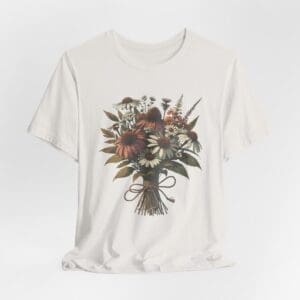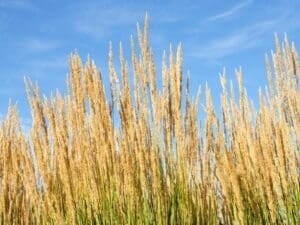The Purple Coneflower (Echinacea purpurea) is a popular perennial wildflower recognized by its vibrant purple blooms and dark cone-shaped centres. Hardy and easy to grow, the Purple Coneflower thrives in gardens across the UK with its showy flowers and long blooming season.
Valued for its medicinal properties and versatility in flower arrangements, the Purple Coneflower deserves a spot in any sunny garden bed or border. This beginner-friendly plant is pleasing to the eye and pollinators alike. Read on to learn all about successfully planting, growing, and caring for the eye-catching Purple Coneflower.
You may be also interested in: Perennials
Planting and Growing Purple Coneflowers
To grow Purple Coneflowers successfully:
- Plant in full sun. Purple Coneflowers thrive in a location receiving at least 6 hours of direct sunlight per day. Partial shade is tolerated but will reduce blooms.
- Prepare the soil. Purple Coneflowers grow best in well-drained soil and do not tolerate wet feet. Before planting, work aged compost or manure into the top 8 inches of soil to enrich and improve drainage. The soil pH should be slightly acidic to neutral.
- Space plants 18-24 inches apart. Give Purple Coneflowers adequate room to reach their mature size of 2-4 feet tall and 1-2 feet wide.
- Dig a hole twice the width of the container root ball. Carefully remove the plant from its container, loosen the roots, and place into the planting hole. Backfill with native soil, water thoroughly to settle.
- Plant in spring or fall. Spring planted coneflowers may bloom the first year while fall planted bulbs likely won’t bloom until the following year. Avoid summer planting.
Caring for Purple Coneflowers
To keep Purple Coneflowers looking their best:
- Water deeply and infrequently. About 1 inch of water per week is sufficient. Overwatering leads to fungal issues.
- Fertilize lightly in early spring with a balanced organic fertilizer. Excess nitrogen leads to floppy growth prone to disease.
- Deadhead spent blooms to encourage reblooming. Use pruners to snip off dead flowers just below the flower head.
- Cut plants back to 6 inches after flowering concludes in fall. Leave the attractive seedheads for winter interest.
- Divide mature clumps every 3-4 years in spring or fall to maintain vigour. Replant divisions to expand your collection.
Propagation of Purple Coneflowers
Purple Coneflowers are easily propagated by:
- Division – The simplest method. Dig up mature plants in spring or fall, separate into pieces with a knife or pruners ensuring each division has roots and 3-5 shoots. Replant immediately. Keep evenly moist until established.
Dividing every few years keeps plants vigorous and prevents overcrowding. Mature plants can be divided into numerous new plants quite quickly.
- Seed – Sow seeds directly outdoors in fall or start seeds indoors 6-8 weeks before last frost. Surface sow seeds and keep evenly moist. Transplant seedlings 18-24 inches apart after danger of frost. It may take 2-3 years for seed-grown plants to reach flowering size. Collect and dry seedheads in fall for spring planting.
Regardless of propagation method, provide the recommended growing conditions for success establishing new Purple Coneflower plants.
Purple Coneflower Pests and Diseases
Purple Coneflowers are relatively pest and disease resistant. Potential problems include:
- Aphids – Small soft-bodied sucking insects that deform foliage and transmit viral diseases. Blast off with water or apply insecticidal soap sprays.
- Spider mites – Tiny pests that suck plant juices. Leaves become stippled and bronzed. Knock off with water or apply neem oil for control.
- Leaf spot – Fungal disease causing circular brown lesions on leaves often following prolonged wet weather. Improve airflow and avoid overhead watering.
- Powdery mildew – Fungal disease creating a white powdery coating on aboveground parts during cool, humid weather. Apply neem oil as a preventative measure.
- Root rot – Caused by overwatering. Allow soil to dry between waterings and improve drainage to prevent.
Practice good cultural care and promptly remove any diseased foliage to prevent spreading issues.
FAQs
What is the best way to water Purple Coneflowers?
Purple Coneflowers are drought-tolerant and require infrequent watering. Deep waterings once a week during dry periods are sufficient. Overwatering can lead to root rot.
How often do Purple Coneflowers need to be fertilized?
Purple Coneflowers are not heavy feeders and require minimal fertilization. A light application of a balanced fertilizer in the spring is usually sufficient.
Do Purple Coneflowers need to be deadheaded?
Deadheading spent blooms encourages continued flowering and prevents the plant from putting energy into seed production. Deadhead by removing spent flowers from the stem.
How do I divide Purple Coneflowers?
Division is the easiest way to propagate Purple Coneflowers. Divide the clumps every 3-4 years in the spring or fall.
How do I grow Purple Coneflowers from seed?
Purple Coneflowers can be grown from seed, but it takes longer to reach flowering size. Sow seeds indoors in the spring and transplant outdoors after the last frost.
Final thoughts
With its vibrant purple blooms and dark cone centres, the hardy Purple Coneflower is a star of the summer garden. This wildflower is easy to grow, tolerates a wide range of conditions, and delivers season-long colour to borders and beds. Provide full sun, moderate watering, and well-drained soil for success growing Echinacea purpurea. Dividing mature plants regularly and deadheading spent blooms keeps this perennial looking its best for years to come. Incorporate the beautiful and versatile Purple Coneflower into your sunny landscape for a touch of prairie charm.







